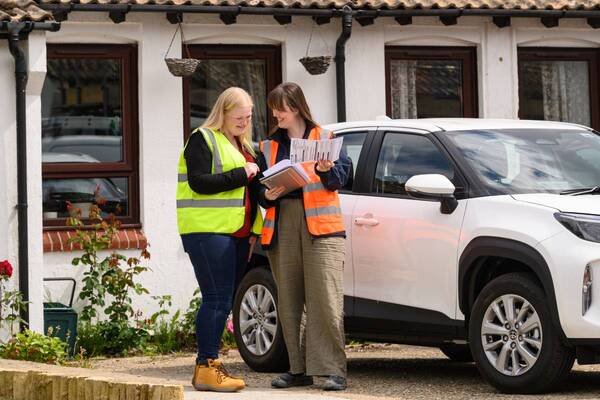Could office landlords hold the key to unlocking much needed housing?
Much has been made of the polarised challenges facing our office and housing markets.
On the one hand, the pandemic drove a colossal shift in the way we work and rendered physical workplaces less critical for many organisations. In fact, one survey found that half of the largest businesses expect to cut their office space in the near future. Meanwhile, Britain’s housing crisis continues to persist, with 4.3 million homes missing from the national market as they were never built. The challenge is twofold; we have too much empty office space, yet the deficit of housing stock means we don’t have enough places in which to live.
While we’ve seen some businesses enforce the great return to the office and city centre footfall has risen post-pandemic, we can’t ignore the fact that employee expectations have shifted, and vacancies remain. Offering hybrid or remote working patterns is non-negotiable for many prospective job seekers. What’s more, greater flexibility is conducive to workforce diversity; for example, being able to work from home can be a necessity for those with caring responsibilities – a greater proportion of which are women.
Even though much has been made of the return to the city, demand for space continues to dwindle; 2023 saw a 17% fall in European office take-up against the pre-pandemic average. In response, many landlords will be considering how weak demand could continue to impact their bottom line – and as such, what they should do with their vacant estate.
But over in the housing sector, the picture is very different and many cities are experiencing localised issues when it comes to housing supply. However, living in proximity to city centres can bring huge economic perks; for residents, it provides easier access to employment opportunities, while urban businesses stand to benefit from their custom. The ‘15-minute city’ is a popular concept and poses real environmental and human benefits, from creating easy access to amenities to limiting polluting vehicle usage by enabling active travel options.
Reimagining space - the solution
Here lies the opportunity – landlords now have the power to protect their profitability while helping to address some of the acute challenges that our society faces.
Repurposing, retrofitting, and renovating is certainly not a ’new’ phenomenon – reimagining unused spaces in the public realm has come to the fore in recent years – and this could be the shining solution to the office space conundrum. Landlords can make the most of their vacant estate by turning offices into residential properties in which people can live, work, and play – as after all, the homes of today are now also the workplaces of many.
It’s a massive opportunity; for example, CBRE estimates that vacant London office space could be used to help deliver a significant 28k homes. And in a world where finances are tight for many, and the race to net zero is increasingly pressing, reviving existing space can be a much more financially and environmentally savvy option than building new facilities, which generate cost implications and carbon emissions through demolition, materials, and construction.
The ‘why’ is clear – but the key will be how
The challenge, though, is how to convert existing office accommodation into livable, healthy spaces that can stand the test of time. Any significant move such as this shouldn’t be taken lightly – it’s a decision with long-term implications which must be driven by the data.
The process should start by assessing the existing property to understand what needs to change to accommodate residents who will live in the space, and have different requirements to the employees for which it was originally designed. Deploying intelligent digital twin technology can be an effective route to understanding how a building currently works, providing the intel for them to make informed decisions about the future of their building and avoid potentially costly guesswork.
Typically, when many buildings are designed, digital energy performance models are put in place to help optimise efficiency and meet mandatory compliance requirements. By redeploying pre-existing 3D design, energy compliance, or BIM models for whole-life building performance modelling – awakening a ‘Sleeping Digital Twin’ – landlords can continue to make the most of earlier investments in the building. They can then utilise insights to uncover future potential, create a decarbonisation plan, and optimise building performance throughout the business’ entire lifecycle.
Prioritising occupant comfort and building resilience
The living environment, from temperature to air quality, plays a critical role in human well-being and must be a key consideration when it comes to creating homes. But in the face of a changing world, where extreme weather events and threats to human health are becoming an everyday reality, building resilience is also a priority for landlords. Mitigating the negative effects of rising temperatures and futureproofing estate to handle adverse conditions must be done sooner rather than later.
This could include looking at ways to electrify heating and cooling as a ‘greener’ way to optimise temperatures for residents or considering the benefits of installing EV chargers to accommodate changing human behaviours. By modelling such opportunities, landlords gain actionable intelligence that helps them to make the right decisions about their buildings – and plan the sequencing of how to deliver upgrades and achieve optimal results.
By using such models to understand the art of the possible and test different potential “what if” scenarios, landlords also gain greater confidence in property upgrade investments, equipped with the knowledge that they are making the most energy- and cost-efficient decisions for the longevity of their building. There’s also a macro benefit from a financial perspective, as making smart decisions like this can help to protect property value. Low-carbon buildings are in increasing demand, with CBRE reporting that energy-efficient commercial property assets saw stronger investment performance between Q1 2021 and Q2 2023.
Ultimately, tech can hold the key to landlords getting the most from what they already have, while enabling them to play a meaningful role in preparing our society for a healthier, comfortable, and more resilient future.
Ben Pettitt is sector lead for real estate at IES


